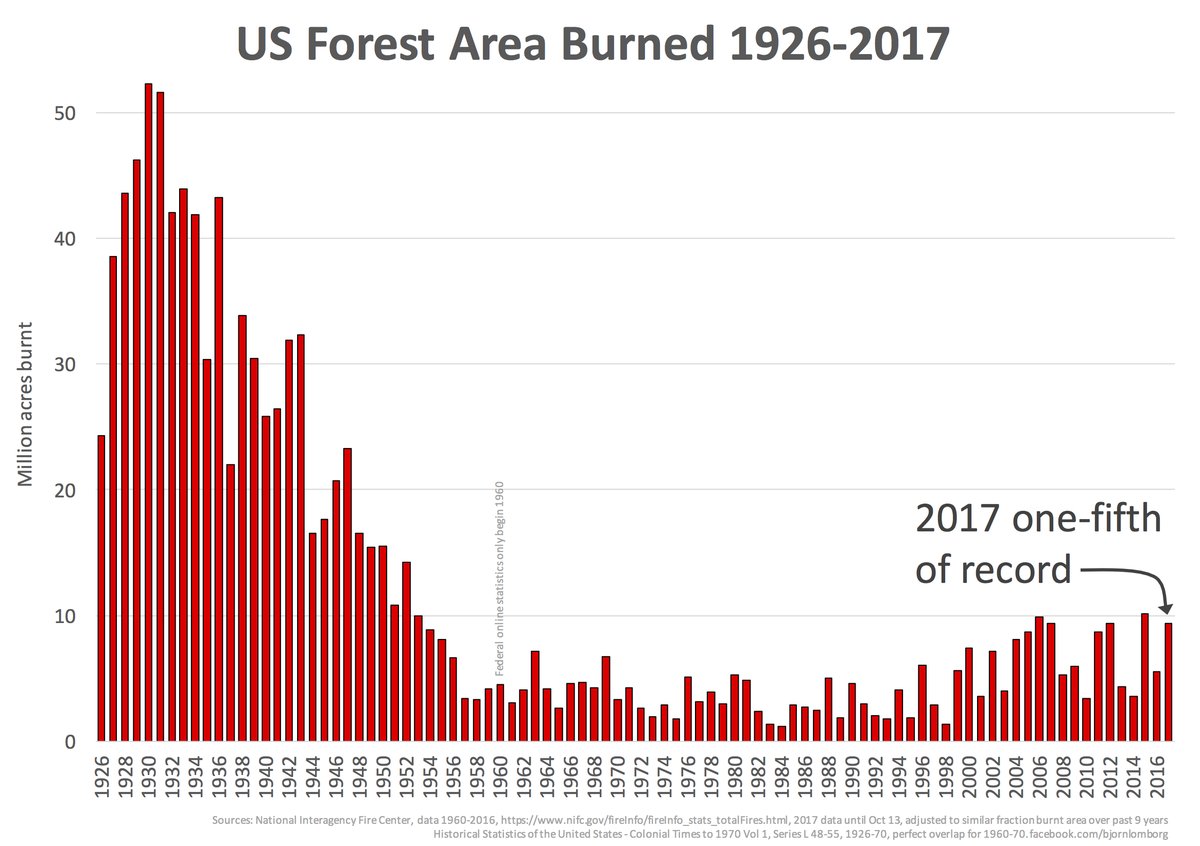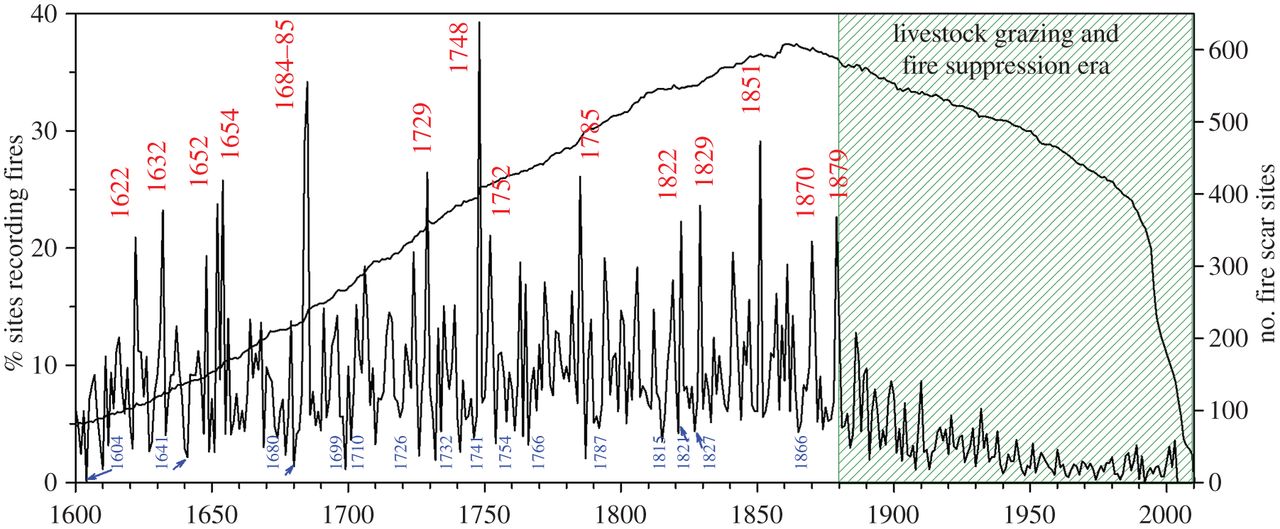"We’re told that climate change caused or intensified California’s wildfires — and that such fires are getting worse. As usual for such scary stories, these claims are only weakly supported by science — except for the ones that are outright fabrications.“If we keep fighting a war with fire, three things are going to happen. We’re going to spend a lot of money, we’re going to take a lot of casualties, and we’re going to lose.”— Stephen Pyne, professor at Arizona State University (source: National Geographic).
(1) Those California Wildfires!
“Gov. Jerry Brown surveyed the devastation Saturday in Ventura …calling it ‘the new normal.’ …“This could be something that happens every year or every few years.’” {Source: LAT.}Climate change is causing more wildfires! Or so we are told. That is a zombie climate myths — repeatedly said, repeatedly debunked by scientists, but too useful to die. When Brown made this claim in 2015 even the LAT said that “Gov. Brown’s link between climate change and wildfires is unsupported, fire experts say.”“{C}limate scientists’ computer models show only that global warming will bring consistently hotter weather in future decades. Their predictions that warming will bring more forest fires — mostly in the Rockies and at other higher elevations, while fires may actually decrease in Southern California — also are for future decades. Even in a warmer world, they say, land management policies will have the greatest effect on the prevalence and intensity of fire. …“‘There is insufficient data,’ said U.S. Forest Service ecologist Matt Jolly. His work shows that over the last 30 years, California has had an average of 18 additional days per year that are conducive to fire. …“Today’s forest fires are indeed larger than those of the past, said National Park Service climate change scientist Patrick Gonzalez. At a symposium sponsored by Brown’s administration, Gonzalez presented research attributing that trend to policies of fighting the fires, which create thick underlayers of growth, rather than allowing them to burn. ‘We are living right now with a legacy of unnatural fire suppression of approximately a century,’ Gonzalez told attendees. …“Fire behavior specialist Jeff Shelton, who provided daily forecasts for the Rocky fire and, later, the Jerusalem fire, said he could not attribute their behavior to climate change. He cited the summer’s dry weather, an abundance of fuel created by a lack of previous fires, and steep slopes that allowed the fires to spread quickly. Ecologists said their behavior was typical of natural chaparral fires, which burn infrequently but intensely. …“‘They are more and more common because we have more and more fuels,’ said Joaquin Ramirez of Technosylva, an international fire modeling company based in San Diego. …Bureau of Land Management fire manager Jeff Tunnell {said} ‘One hundred years of fire suppression is building fuel beds,’ Tunnell said. ‘Almost any year can produce a fire like this one.'”See the current wildfire stats compared to recent years. For a detailed debunking see this by Cliff Mass: “Are California Coastal Wildfires Connected With Global Warming: The Evidence Says No.” He is a Professor of Atmospheric Science at U WA.(2) But US wildfires are getting worse! Unprecedented!
(a) See the graph that must not be seen, so journalists never show it.
This myth has repeatedly been debunked, but is too useful to die. David B. South, Emeritus Professor, of Forestry at Auburn U, showed the actual data in his Senate testimony on 3 June 2014 (page 2). Bjorn Lomborg posted an updated version of his graph, using the same sources. Click to enlarge graph. Excerpt…“Fires in California and elsewhere are devastating. But US fires are nowhere near the record. More likely about one-fifth of the records in 1930 and 1931. Reuters (along with many others), tell us the current US fires are historic …“Yet, the official historical data of the United States tells a different story. Look at the Historical Statistics of the United States – Colonial Times to 1970 (p537). There we have statistics for area burnt since 1926 and up to 1970. Reassuringly, the data for 1960-1970 *completely overlap* (that from the National Interagency Fire Center}. This is the same data series.“And when you look at the whole data series, *every year* from 1926-1952 – over a quarter of a century – saw higher, and mostly much higher forest areas burnt than the modern record set in 2015.“This is not (as some have suggested) an artifact of the US gradually being deforested (and hence having less land to burn). The USDA Forest Service in their Historical Overview (p7) finds that the US “forest area has been relatively stable since 1910” – if anything slightly increasing since 1910 (which would help push up the burnt area slightly).”
(b) Incidence of wildfires in North America 1600-2000. Peaked in mid-19th C.
“Multiscale perspectives of fire, climate and humans in western North America and the Jemez Mountains, USA” by Thomas W. Swetnam et al. in Phil Trans B, 5 June 2016. Fires peaked in the mid-19th century! Click to enlarge the graph.“The combined record of fire occurrence from more than 800 sites in western North America shows relatively high fire frequency prior to ca 1900, and a high degree of synchrony in both large and small fire years. The 15 largest and smallest fire years are labelled. A pronounced decrease in fire frequency occurred at the time of Euro-American settlement, coinciding approximately with the arrival of railroads, intensive livestock grazing, removal of many Native American populations, and subsequently organized and mechanized fire fighting by government agencies.”
(c) A smaller and more precise record: fires in Yosemite National Park. Peaked in mid-19th C.
“Climatic and human influences on fire regimes in mixed conifer forests in Yosemite National Park, USA” by Alan H. Taylor and Andrew E. Scholl in Forest Ecology and Management, 1 March 2012 (gated). Different data, same pattern — a peak in the mid-19th century, followed by a long decline. Click to enlarge."Wildfires in Yosemite National Park: 1600-2000.
Sunday, December 17, 2017
Is climate change the culprit causing California’s wildfires?
By Larry Kummer.
Subscribe to:
Post Comments (Atom)



No comments:
Post a Comment
Note: Only a member of this blog may post a comment.